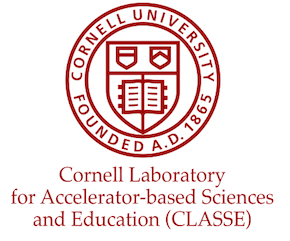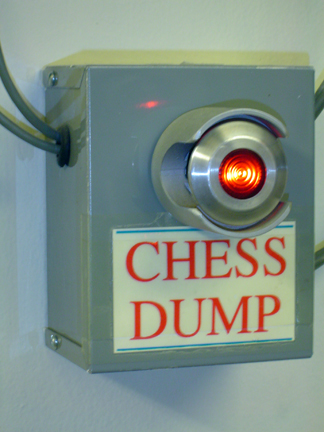You are here: CLASSE Wiki>Safety/Handbook Web>GlossarY (09 May 2023, RigelLochner)Edit Attach
Glossary
accelerator : an apparatus that accelerates elementary particles to higher energies. At Wilson Lab, this usually refers to the linac, the synchrotron, and the storage ring together; each is individually an accelerator, as is the ERL : an apparatus that accelerates elementary particles to higher energies. At Wilson Lab, this usually refers to the linac, the synchrotron, and the storage ring together; each is individually an accelerator, as is the ERL |
acute hazard  : as defined by the EPA, "conditions that create the potential for injury or damage to occur ... as a result of an instantaneous or short duration exposure..." : as defined by the EPA, "conditions that create the potential for injury or damage to occur ... as a result of an instantaneous or short duration exposure..." |
ALARA  : "As low as is reasonably achievable" means making every reasonable effort to maintain exposures to radiation as far below the dose limits specified by the Nuclear Regulatory Commission and New York State Department of Health as is practical : "As low as is reasonably achievable" means making every reasonable effort to maintain exposures to radiation as far below the dose limits specified by the Nuclear Regulatory Commission and New York State Department of Health as is practical |
Annex  : a supplemental work area for Wilson Lab, located just across Dryden Road : a supplemental work area for Wilson Lab, located just across Dryden Road |
beam  : in general, a term for any flow of elementary particles created by an accelerator; at Wilson Laboratory this can refer to the electron or positron beams in CESR or ERL, or the X-ray beams used in CHESS (e.g. "beam time") : in general, a term for any flow of elementary particles created by an accelerator; at Wilson Laboratory this can refer to the electron or positron beams in CESR or ERL, or the X-ray beams used in CHESS (e.g. "beam time") |
biohazard facility  : the enclosure in L0, inside CHESS East, that includes a bio-hazard room, access room, control room, dark room, and F1 station; it provides an appropriate environment for safe handling of biologically hazardous viral materials : the enclosure in L0, inside CHESS East, that includes a bio-hazard room, access room, control room, dark room, and F1 station; it provides an appropriate environment for safe handling of biologically hazardous viral materials |
cave  : a room-sized enclosure for CHESS optics, located upstream of any hutch; shielding of its walls and door contain X-ray radiation during CHESS running. Only CHESS staff access caves, not CHESS users : a room-sized enclosure for CHESS optics, located upstream of any hutch; shielding of its walls and door contain X-ray radiation during CHESS running. Only CHESS staff access caves, not CHESS users |
CESR  : (Cornell Electron Storage Ring) the facility which circulates electrons and positrons in opposite directions after being accelerated by the GlossarY and GlossarY : (Cornell Electron Storage Ring) the facility which circulates electrons and positrons in opposite directions after being accelerated by the GlossarY and GlossarY |
CHESS  : (Cornell High Energy Synchrotron Source) the facility which uses high energy X-rays from CESR for a broad range of research : (Cornell High Energy Synchrotron Source) the facility which uses high energy X-rays from CESR for a broad range of research |
CLASSE  : (Cornell Laboratory for Accelerator-based ScienceS and Education) the laboratory umbrella inclusive of LEPP and CHESS laboratories and the ERL project : (Cornell Laboratory for Accelerator-based ScienceS and Education) the laboratory umbrella inclusive of LEPP and CHESS laboratories and the ERL project |
CLEO  : the detector (and collaboration) that studied electron-positron annihilations produced by CESR for three decades; its skeleton remains in L0 : the detector (and collaboration) that studied electron-positron annihilations produced by CESR for three decades; its skeleton remains in L0 |
CMS  : (Compact Muon Solenoid) the large particle physics detector acquiring data at CERN's Large Hadron Collider for the purpose of exploring the TeV energy scale; also, the large, multi-institution collaboration operating the experiment. Cornell is an active member group within CMS. : (Compact Muon Solenoid) the large particle physics detector acquiring data at CERN's Large Hadron Collider for the purpose of exploring the TeV energy scale; also, the large, multi-institution collaboration operating the experiment. Cornell is an active member group within CMS. |
continuous wave (CW)  : an electromagnetic wave of constant amplitude and frequency; a CW laser produces a continuous beam, as opposed to a pulsed laser : an electromagnetic wave of constant amplitude and frequency; a CW laser produces a continuous beam, as opposed to a pulsed laser |
controlled area  : area where radiation from CLASSE activities could potentially exceed two mrem in one hour or 100 mrem in one year (i.e. continuous exposure to 0.05 mrem/hr for 2000 hours, a "working year"); a radiation badge must be worn by any CLASSE personnel here, and a dosimeter carried by any host who is accompanied by visitors. Signage should conspicuously mark entry into such an area. : area where radiation from CLASSE activities could potentially exceed two mrem in one hour or 100 mrem in one year (i.e. continuous exposure to 0.05 mrem/hr for 2000 hours, a "working year"); a radiation badge must be worn by any CLASSE personnel here, and a dosimeter carried by any host who is accompanied by visitors. Signage should conspicuously mark entry into such an area. |
crash button | crash cord  : a cord used to shut off power to most equipment in the CESR tunnel in an emergency; located at shoulder height along the tunnel wall : a cord used to shut off power to most equipment in the CESR tunnel in an emergency; located at shoulder height along the tunnel wall 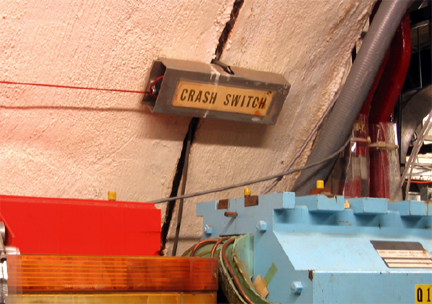 |
declaration sheet  : a CHESS form that must be completed by an experimenter before beam time is allotted; it describes any hazardous materials to be brought to Wilson Laboratory : a CHESS form that must be completed by an experimenter before beam time is allotted; it describes any hazardous materials to be brought to Wilson Laboratory |
dewar  : a thermally insulated container used to hold ultra-cold refrigerants such as liquid nitrogen or liquid helium : a thermally insulated container used to hold ultra-cold refrigerants such as liquid nitrogen or liquid helium 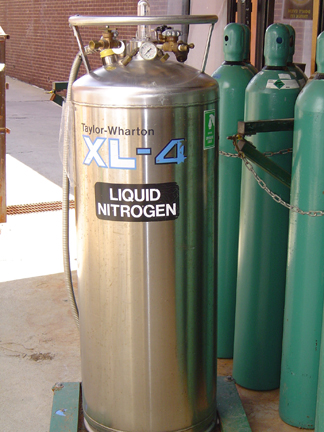 |
digital volt meter  : (or DVM) a hand-held diagnostic device with digital readout used in electrical work to measure voltage and other electrical properties of a circuit : (or DVM) a hand-held diagnostic device with digital readout used in electrical work to measure voltage and other electrical properties of a circuit 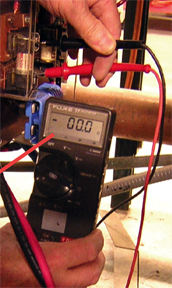 |
dosimeter  : a hand-held personal radiation monitor that displays (in analog or digital format) accumulated radiation exposure in real time : a hand-held personal radiation monitor that displays (in analog or digital format) accumulated radiation exposure in real time 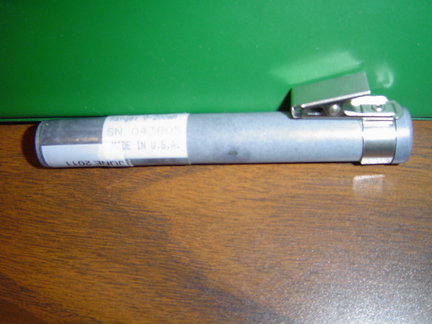 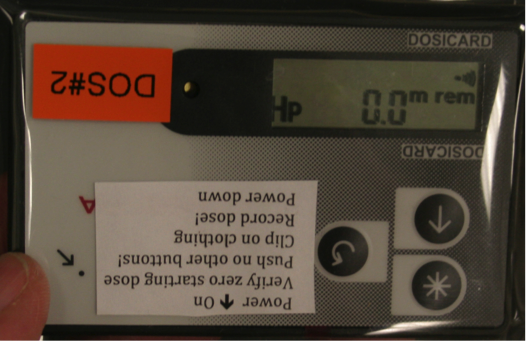 |
| dump button | EHS  : Cornell's Department of Environment, Health and Safety, located at 395 Pine Tree Road, Suite 210 (near East Hill Plaza, adjacent to the car wash), phone (607)(25)5-8200 : Cornell's Department of Environment, Health and Safety, located at 395 Pine Tree Road, Suite 210 (near East Hill Plaza, adjacent to the car wash), phone (607)(25)5-8200 |
EPA  : (Environmental Protection Agency) an agency of the federal government charged with protecting human health and the environment : (Environmental Protection Agency) an agency of the federal government charged with protecting human health and the environment |
ERL  : (Energy Recovery Linac) a proposed design for an x-ray source in which electrons produced by a laser impinging on a photocathode are accelerated and decelerated with SRF technology; see also Phase 1 : (Energy Recovery Linac) a proposed design for an x-ray source in which electrons produced by a laser impinging on a photocathode are accelerated and decelerated with SRF technology; see also Phase 1 |
exclusion area  : controlled area where access is prohibited while radiation-producing equipment (or sealed source) is in use, for which (at CLASSE) an interlock system prevents powering said equipment if personnel are present or its perimeter is violated or otherwise found to be insecure : controlled area where access is prohibited while radiation-producing equipment (or sealed source) is in use, for which (at CLASSE) an interlock system prevents powering said equipment if personnel are present or its perimeter is violated or otherwise found to be insecure |
Geiger-Mueller counter  : hand-held monitor with real-time visual and audible readout of instantaneous exposure rate to gamma and x-ray radiation; does not record accumulated exposure : hand-held monitor with real-time visual and audible readout of instantaneous exposure rate to gamma and x-ray radiation; does not record accumulated exposure 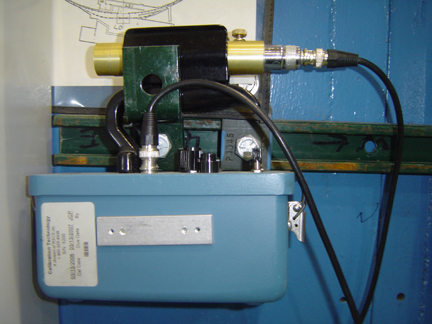 |
GeV  : (billion (Giga) electron volts) a unit of energy used to characterize an individual elementary particle; a single proton at rest has energy of about 1 GeV; each electron or positron in CESR has between 1.5 and 6 GeV : (billion (Giga) electron volts) a unit of energy used to characterize an individual elementary particle; a single proton at rest has energy of about 1 GeV; each electron or positron in CESR has between 1.5 and 6 GeV |
ground-fault circuit interrupter  : (GFCI) a device present in many alternating current circuits, protects against electrical shock by interrrupting the current if sufficient leakage to ground is detected : (GFCI) a device present in many alternating current circuits, protects against electrical shock by interrrupting the current if sufficient leakage to ground is detected |
grounding stick  : a metal wand with a non-conducting handle and a grounding strap used to de-energize high-voltage equipment : a metal wand with a non-conducting handle and a grounding strap used to de-energize high-voltage equipment |
hutch  : (also, "station") a room-sized enclosure for CHESS experiments; shielding of its walls and door contain X-ray radiation during exposures of experimental samples. A hutch is accessed by CHESS users; if the sliding door is open, beams are prevented from entering the hutch. A hutch is downstream of a cave : (also, "station") a room-sized enclosure for CHESS experiments; shielding of its walls and door contain X-ray radiation during exposures of experimental samples. A hutch is accessed by CHESS users; if the sliding door is open, beams are prevented from entering the hutch. A hutch is downstream of a cave 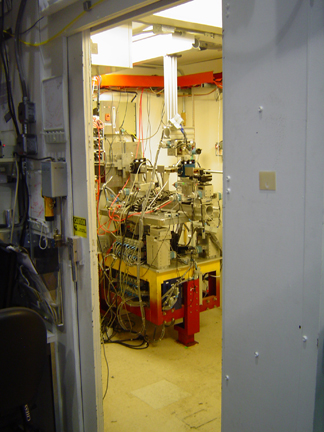 |
interaction point  : (also, "IP") the location where particle bunches collide in particle physics experiments; e.g. the CLEO detector : (also, "IP") the location where particle bunches collide in particle physics experiments; e.g. the CLEO detector |
interlock system  : a system of keys and light beams that monitors access by people into a exclusion area and prevents an accelerator from turning on if people remain inside or enter such an area : a system of keys and light beams that monitors access by people into a exclusion area and prevents an accelerator from turning on if people remain inside or enter such an area |
ionizing radiation  : a flow of elementary particles or electromagnetic waves energetic enough to remove electrons from atoms and disrupt molecules in living organisms; see non-ionizing radiation; can originate from cosmic rays, decays of radioisotopes, particle accelerators, medical scans : a flow of elementary particles or electromagnetic waves energetic enough to remove electrons from atoms and disrupt molecules in living organisms; see non-ionizing radiation; can originate from cosmic rays, decays of radioisotopes, particle accelerators, medical scans |
kirk key  : a one-lock, one-person lockout system which prevents equipment from being operated if the key is missing from its lock : a one-lock, one-person lockout system which prevents equipment from being operated if the key is missing from its lock |
L0  : the large experimental hall (Rm #150) on the first floor of Wilson Laboratory housing the south end of the synchrotron and CESR, the CLEO detector pit and skeleton, CHESS East, the ERL Phase 1a prototype, and other facilities : the large experimental hall (Rm #150) on the first floor of Wilson Laboratory housing the south end of the synchrotron and CESR, the CLEO detector pit and skeleton, CHESS East, the ERL Phase 1a prototype, and other facilities |
L0E  : the large hall (Rm #151) on the first floor of Wilson Laboratory just east of L0, housing the vacuum lab, machine shops, lab space, office and work areas, and other facilities : the large hall (Rm #151) on the first floor of Wilson Laboratory just east of L0, housing the vacuum lab, machine shops, lab space, office and work areas, and other facilities |
LEPP  : (Laboratory for Elementary-Particle Physics) one of the two primary research arms of CLASSE, encompassing accelerator R&D (w/SRF, ERL, CESR) and particle physics at the energy frontier (CMS, ILC) : (Laboratory for Elementary-Particle Physics) one of the two primary research arms of CLASSE, encompassing accelerator R&D (w/SRF, ERL, CESR) and particle physics at the energy frontier (CMS, ILC) |
linac  : (linear accelerator) an accelerator with a straight trajectory; the 100-foot injector in LS1 of electrons and positrons into the synchrotron and a portion of the ERL Phase 1a project are both linacs : (linear accelerator) an accelerator with a straight trajectory; the 100-foot injector in LS1 of electrons and positrons into the synchrotron and a portion of the ERL Phase 1a project are both linacs |
Lock/Tag/Verify (LTV)  : a system of locks and tags used to prevent equipment from being powered-on while a person is working on or near it (see Cornell EHS LTV page) : a system of locks and tags used to prevent equipment from being powered-on while a person is working on or near it (see Cornell EHS LTV page) 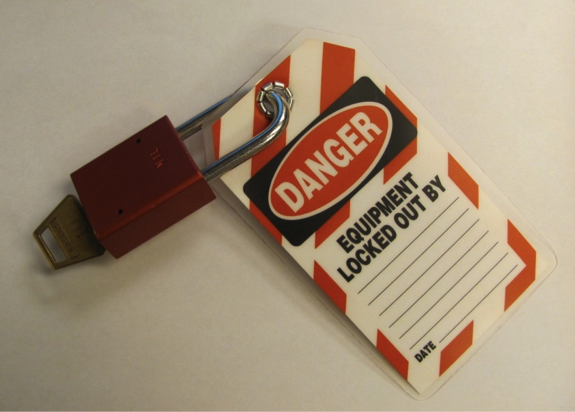 |
LS1  : the long and narrow hall (Rm #152) on the first floor of Wilson Laboratory just north of L0, housing the linac for the synchrotron, starting in room 101 and ending in the East flare : the long and narrow hall (Rm #152) on the first floor of Wilson Laboratory just north of L0, housing the linac for the synchrotron, starting in room 101 and ending in the East flare |
LS2  : the long and narrow hall (Rm #252) on the second floor of Wilson Laboratory one floor above LS1, starting in the CESR control room and ending in the hallway behind L0E : the long and narrow hall (Rm #252) on the second floor of Wilson Laboratory one floor above LS1, starting in the CESR control room and ending in the hallway behind L0E |
SDS  : (Safety Data Sheets) safety-related information, in a standardized format, about chemicals and other materials, which includes a list of ingredients, safe use instructions, hazards, exposure symptoms, and emergency procedures; locate them via search engine, or at the SIRI site or the local CHESS site : (Safety Data Sheets) safety-related information, in a standardized format, about chemicals and other materials, which includes a list of ingredients, safe use instructions, hazards, exposure symptoms, and emergency procedures; locate them via search engine, or at the SIRI site or the local CHESS site |
mrem  : (millirem; one-thousandth of a rem, a metric unit) unit of accumulated ionizing radiation exposure, adjusted for its potential for biological damage; an alternate unit is the Sievert (Sv); 100 mrem = 1 mSv : (millirem; one-thousandth of a rem, a metric unit) unit of accumulated ionizing radiation exposure, adjusted for its potential for biological damage; an alternate unit is the Sievert (Sv); 100 mrem = 1 mSv |
non-ionizing radiation  : a flow of elementary particles or electromagnetic waves that is not ionizing radiation; includes radar, microwave, infrared, radio, television signals, magnetic fields, and electric power fields : a flow of elementary particles or electromagnetic waves that is not ionizing radiation; includes radar, microwave, infrared, radio, television signals, magnetic fields, and electric power fields |
NRC  : (Nuclear Regulatory Commission) the federal agency which regulates and licenses radioactive materials to protect public health and safety : (Nuclear Regulatory Commission) the federal agency which regulates and licenses radioactive materials to protect public health and safety |
OSHA  : (Occupational Safety and Health Administration) the federal agency responsible for workplace safety : (Occupational Safety and Health Administration) the federal agency responsible for workplace safety |
Phase 1  : an R&D phase of the ERL project, located along the south wall of L0 : an R&D phase of the ERL project, located along the south wall of L0 |
pulsed laser  : a laser which delivers its beam in concentrated pulses (as opposed to a CW laser); the instantaneous power can be much greater than the average power, and can hence pose a greater safety challenge : a laser which delivers its beam in concentrated pulses (as opposed to a CW laser); the instantaneous power can be much greater than the average power, and can hence pose a greater safety challenge |
radiation  : a flow of elementary particles or electromagnetic waves which can be ionizing or non-ionizing : a flow of elementary particles or electromagnetic waves which can be ionizing or non-ionizing |
radiation badge  : a clip-on badge worn on clothing that records accumulated ionizing radiation exposure over an extended period of time (usually one or two months), after which it is returned to a vendor for evaluation of the dose; exposure records are maintained by the CLASSE Radiation Safety Specialist (RSS) and EHS : a clip-on badge worn on clothing that records accumulated ionizing radiation exposure over an extended period of time (usually one or two months), after which it is returned to a vendor for evaluation of the dose; exposure records are maintained by the CLASSE Radiation Safety Specialist (RSS) and EHS  |
radiation-producing equipment  : (RPE) any apparatus capable of producing ionizing radiation when it is powered on and for which this radiation ceases to be generated when it is powered off; examples include any accelerator, an RF cavity, or an x-ray tube : (RPE) any apparatus capable of producing ionizing radiation when it is powered on and for which this radiation ceases to be generated when it is powered off; examples include any accelerator, an RF cavity, or an x-ray tube |
RPH  : Radiation Permit Holder, a Cornell EHS designation, responsible for administration and operation/use of RPE or sealed sources; CLASSE has several RPH's : Radiation Permit Holder, a Cornell EHS designation, responsible for administration and operation/use of RPE or sealed sources; CLASSE has several RPH's |
RSS  : CLASSE Radiation Safety Specialist (see Who's Who), responsible for maintenance, calibration, and advice on radiation measurement devices in CLASSE as well as all aspects of radioactive source administration : CLASSE Radiation Safety Specialist (see Who's Who), responsible for maintenance, calibration, and advice on radiation measurement devices in CLASSE as well as all aspects of radioactive source administration |
radioactive source  : a packaged, usually sealed, concentrated amount of a specific radioisotope manufactured for the purpose of generating a particular type and energy of ionizing radiation : a packaged, usually sealed, concentrated amount of a specific radioisotope manufactured for the purpose of generating a particular type and energy of ionizing radiation |
radioactivity  : the radiation emitted by radioisotopes : the radiation emitted by radioisotopes |
radioisotope"  : an unstable chemical element with the same number of protons and electrons as its stable partner but with a different number of neutrons; when it decays with a characteristic half-life, it emits radiation as it decays to lighter elements, which themselves might also be radioisotopes : an unstable chemical element with the same number of protons and electrons as its stable partner but with a different number of neutrons; when it decays with a characteristic half-life, it emits radiation as it decays to lighter elements, which themselves might also be radioisotopes |
RF cavity  : (radio-frequency cavity, part of an RF system) A specially-shaped, hollow metal volume that delivers energy to an electron and/or positron beam when stimulated by electromagnetic fields that oscillate at high frequency : (radio-frequency cavity, part of an RF system) A specially-shaped, hollow metal volume that delivers energy to an electron and/or positron beam when stimulated by electromagnetic fields that oscillate at high frequency 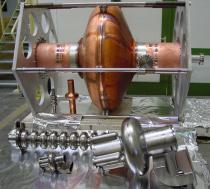 |
RF System : (radio-frequency system) a support system for an accelerator which supplies energy to particles via an RF cavity : (radio-frequency system) a support system for an accelerator which supplies energy to particles via an RF cavity |
residual radioactivity  : radioactivity in material near or part of an accelerator, induced by errant high energy beam particles, creating radioisotopes which remain even after the accelerator has been turned off : radioactivity in material near or part of an accelerator, induced by errant high energy beam particles, creating radioisotopes which remain even after the accelerator has been turned off |
ring badge  : a special radiation badge designed to be worn on one or more fingers of a radiation worker concerned about localized exposure : a special radiation badge designed to be worn on one or more fingers of a radiation worker concerned about localized exposure |
| search button | station enable key  : when removed, makes it impossible to open the (X-ray) beam stops on that particular CHESS station : when removed, makes it impossible to open the (X-ray) beam stops on that particular CHESS station |
SRF  : Superconducting RF Cavity or system; also, the group which develops, builds, & maintains such systems : Superconducting RF Cavity or system; also, the group which develops, builds, & maintains such systems |
synchrotron  : a circular ring of magnets, RF cavities, vacuum pumps and other components to accelerate particles in a circle; at CLASSE, most people refering to "the synchrotron" mean the older accelerator built in the late 1960's currently used to accelerate positrons and electrons and inject them into CESR (also a synchrotron) : a circular ring of magnets, RF cavities, vacuum pumps and other components to accelerate particles in a circle; at CLASSE, most people refering to "the synchrotron" mean the older accelerator built in the late 1960's currently used to accelerate positrons and electrons and inject them into CESR (also a synchrotron) |
transfer line  : a beam line for particle transfer from the synchrotron into CESR : a beam line for particle transfer from the synchrotron into CESR |
two-person rule  : No operation involving a known risk shall be carried out by any person working alone; risk shall be considered eliminated only after two competent people have agreed to this judgment : No operation involving a known risk shall be carried out by any person working alone; risk shall be considered eliminated only after two competent people have agreed to this judgment |
uncontrolled area  : area where the potential radiation dose rate from CLASSE activities is below two mrem per hour and 100 mrem per year; no radiation badge or dosimeter are needed here : area where the potential radiation dose rate from CLASSE activities is below two mrem per hour and 100 mrem per year; no radiation badge or dosimeter are needed here |
vacuum system  : the collective assembly of vacuum pipes, vacuum pumps (hundreds), pressure gauges, and other instrumentation that provide a virtually unobstructed (by molecules of air, water, or other materials) path for a beam in an accelerator : the collective assembly of vacuum pipes, vacuum pumps (hundreds), pressure gauges, and other instrumentation that provide a virtually unobstructed (by molecules of air, water, or other materials) path for a beam in an accelerator |
Edit | Attach | Print version | History: r52 < r51 < r50 < r49 | Backlinks | View wiki text | Edit wiki text | More topic actions
Topic revision: r52 - 09 May 2023, RigelLochner
-
 Safety/Handbook Web
Safety/Handbook Web
-
 Create New Topic
Create New Topic
-
 Index
Index
-
 Search
Search
-
 Changes
Changes
-
 Notifications
Notifications
-
 RSS Feed
RSS Feed
-
 Statistics
Statistics
-
 Preferences
Preferences
- Webs
-
 ACC
ACC
-
 ACL
ACL
-
 Bunch
Bunch
-
 Private
Private
-
 BusinessOffice
BusinessOffice
-
 CBB
CBB
-
 NSF
NSF
-
 CBETA
CBETA
-
 CESR
CESR
-
 Private
Private
-
 CHESS
CHESS
-
 FMB
FMB
-
 Maia
Maia
-
 XIMG
XIMG
-
 CHEXS
CHEXS
-
 CLASSE
CLASSE
-
 Inventory
Inventory
-
 Communications
Communications
-
 CLEO
CLEO
-
 AC
AC
-
 Administration
Administration
-
 RunMan
RunMan
-
 SW
SW
-
 CMSPhase2MREFC
CMSPhase2MREFC
-
 Computing
Computing
-
 Blogs
Blogs
-
 Newsletter
Newsletter
-
 Obsolete
Obsolete
-
 Private
Private
-
 Cosmology
Cosmology
-
 Private
Private
-
 DarkPhoton
DarkPhoton
-
 ERL
ERL
-
 Private
Private
-
 EngineeringDesignDrafting
EngineeringDesignDrafting
-
 G2
G2
-
 HEP
HEP
-
 DBSWorkshop
DBSWorkshop
-
 SWIG
SWIG
-
 HLLHCCMSMREFC
HLLHCCMSMREFC
-
 HMF
HMF
-
 HumanResources
HumanResources
-
 Private
Private
-
 ILC
ILC
-
 Americas
Americas
-
 CesrTA
CesrTA
-
 Proposal
Proposal
-
 DampingRings
DampingRings
-
 AreaLeaders
AreaLeaders
-
 CTA09
CTA09
-
 ILCDR06
ILCDR06
-
 ILCDR07_KEK
ILCDR07_KEK
-
 ILCDR08
ILCDR08
-
 S3TaskForce
S3TaskForce
-
 Private
Private
-
 CesrTA
CesrTA
-
 WWS
WWS
-
 MacCHESS
MacCHESS
-
 Main
Main
-
 People
People
-
 PhotocathodeBrightBeams
PhotocathodeBrightBeams
-
 REU
REU
-
 Private
Private
-
 SRF
SRF
-
 PCsrfcn1
PCsrfcn1
-
 Safety
Safety
-
 Handbook
Handbook
-
 Private
Private
-
 ExternalResources
ExternalResources
-
 Sandbox
Sandbox
-
 TestWeb
TestWeb
-
 Testauth
Testauth
-
 System
System
-
 Theory
Theory
-
 Communications
Communications
-
 Documents
Documents
-
 Phase2MREFC
Phase2MREFC
-
 WebDev
WebDev
-
 Private
Private
-
 XLEAP
XLEAP
 Copyright © by the contributing authors. All material on this collaboration platform is the property of the contributing authors.
Copyright © by the contributing authors. All material on this collaboration platform is the property of the contributing authors. Ideas, requests, problems regarding CLASSE Wiki? Send feedback
